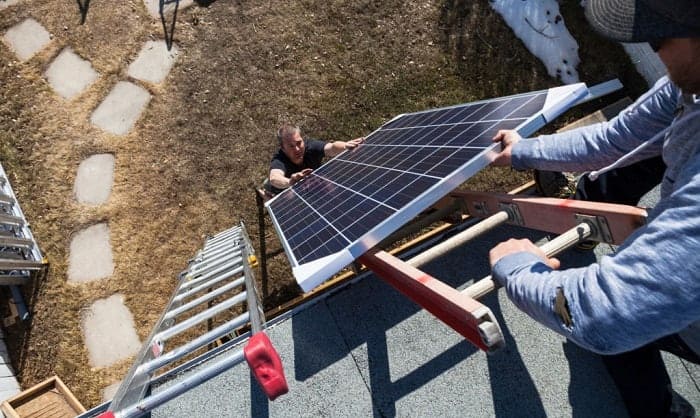Are you pondering how to mount solar panels on roof surfaces? Fundamentally, rooftops are deemed the most suitable location to install solar panels. This is because they obtain a generous amount of sunlight exposure, there isn’t anything that obstructs them, and they are durable.
The installation process can be slightly specialized; hence, it would be great to get a contractor to do the work for you. However, there’s no harm in learning about mounting solar panels on roof.
If you’re in the construction field or would like to uncover what the entire solar panel installation process involves, read the rest of this post.
Table of Contents
Things You Need to Consider to Install Solar Panels on Rooftop
Before installing solar panel systems, there are a few things you need to check out, and these include:
The Structure of your Roof
Make sure that your roof is in good condition before you install solar panel on roof areas. Manufacturers specifically design their solar panels to work for many years; generally speaking, they can be of service for 25 years. This is why your roof should be incredibly durable.
Fix your damaged roof before you mount the solar panels. Unquestionably, fixing the damage early on will save you the additional expenses and hassle of lifting the panels and re-attaching them after fixing the roof.
Note that there are different types of roofs; however, the most common among them is the asphalt shingle roof.
The Location of your House
For example, do you have growing fruit-bearing trees that could block your solar panels? Remove anything that could block the solar panels from absorbing full sunlight.
The gist here is that you need to ensure your panel’s location allows sunlight absorption.
The Strength of your Roof
Is your roof solid enough to support the additional weight of solar panels? Solar panels aren’t bulky; in general, they weigh up to 2.7 lbs. for every square foot.
Regardless, consider having a structural engineer inspect your roof so that you can ensure it suits your panels.
How to Attach Solar Panels to Roof
Before starting the installation process, you need some required items. Having the installation materials complete and accessible can help you finish the job with fewer struggles.
Materials Needed
- Tape measure
- Drill bit and a drill
- Chalk line
- Ladder
- Pencil
Note that the other assembly materials or hardware should be included in the solar panel kit you purchased. If the installation items are all set, you can now proceed to the step-by-step solar panel mounting process.
Instructions for Installing Solar Panels on Roofs
Here are the pro tips when mounting solar panel systems on shingle roofs:
Step 1: Lay out the installation materials you need.
Make sure that all the materials necessary for installation are nearby. You surely wouldn’t want to go from the roof and back repeatedly.
Step 2: Determine where the stanchions go.
Decide where the stanchions go. These refer to the large screws that keep the solar panels in place. When mounted, they should be solid enough and can withstand tearing the panels from your roof (upforce).
Find the roof rafters with the aid of a stud finder or your home’s blueprint. These will help you figure out the correct placement of the stanchions. Position the stanchions at least 4 feet apart.
Step 3: Fasten the screws to the roof.
When fastening the screws to the roof, utilize a drill to create holes in the rafters.
Step 4: Tightly put the screws in the holes and secure them.
It would help if you tightly secured the lower and upper aluminum rails to the stanchions. Utilize bolts to do this. Since optimal tightness is required, utilize an impact driver to achieve this.
Afterward, make sure that you seal the screws tightly to maintain the thermal envelope of your home. Substantially, thermoseal roofing is the most excellent way to execute this.
This approach will help keep an incredibly tight lock on your roof and prevent any elements from getting inside. Leakage is less likely to emerge if the stanchions are correctly installed.
Step 5: Gauge the distance from the rails.
Gauge the distance from the rails when installing solar panels. Put a measuring tape diagonally from the top of one rail to the bottom of the rail situated directly across from it.
Repeat the process on the other side. The measurements should be equal. If they are, the rails are parallel to each other. On the other hand, you’ll need to make some adjustments if the measurements aren’t equal.
Step 6: Install the middle rail.
The next step will be to set up the center rail. Note that the center rail must be aligned with the lower and upper rails.
Step 7: Bring power to the solar panels.
Bringing power to your solar panels entails putting wires into them and running them to the power inverter kit to make up your conductor system. Then, install the power inverter kit below each of your panels.
Set up some 6-gauge copper grounding wire into the inverters. This process will create your conductor system. Link the wire connections from one solar array to the other.
Step 8: Position the panels on top of the previously installed stanchions.
Finally, place the panels above the previously installed stanchions. Link the plug connections. It is also essential to screw the securing clips onto the rails to ensure that the panels are solid as a rock.
You will need to deal with more electrical work after all these. Start extending some wires from the panels and link them to an electrical meter. You’ll also need to link the wires to an electrical sub-panel.
Affixing Solar Panel Systems on the Other Roof Types
Standing Seam Metal Roof
Among the other types of roofs, this one is the easiest to deal with when roof mounting solar panels.
A standing seam metal roof is super sturdy. Moreover, it saves you the trouble of determining where the trusses are. Since you can utilize a U-clamp to mount the panels, it is unnecessary to drill holes.
Tile Roof
It is required to remove a few tiles when affixing the panels on a tile roof. From there, you can mount the tile hooks and flashings onto your roof.
The potential setback of affixing panels on a tile roof is the possibility of damage during the installation process. You might need to change the tiles once you have accomplished the job.
Flat Roof
Use a ballasted racking when installing the solar panel systems on a flat roof. Cinder blocks can reinforce the entire structure of your solar panel.
This type of racking allows you to adjust it to a 30-degree angle to absorb an ample amount of sunlight.
Is It Safe to Mount Solar Panels on the Roof
You have nothing to worry about if safety is your concern when mounting solar panels on your roof. Installing solar panels on your roof is not as damaging as you imagine. Of course, you’ve got to ensure that you install them correctly.
Many homeowners are careful of holes in their roofs. This is normal because once the roof is damaged; you’ll need to prepare yourself for an expensive repair and renovation cost. Except for flat roofs and standing metal roofs, roof penetrations are needed to fasten the solar panels correctly.
Nonetheless, a correctly mounted solar panel system should not bring about any damage or leakage, even if penetrations are required.
The good news is that the solar industry has been setting up rooftop solar equipment for many years now, and appropriate measures have been developed. Such measures are designed to reduce the risk of any emerging water damage incidents due to incorrect solar panel system installation.
For a fact, mounting solar panels onto the roof can offer an additional benefit, and this is protecting your roof. Did you know that solar panels act as a protector against inevitable and typical wear and tear?
Solar panels are superbly durable and specifically engineered to tolerate much of what outdoor elements throw their way. They execute an excellent job of keeping roofs dry and tidy underneath.
It is vital for you to work with a trusted and licensed solar installer. In doing so, this will ensure that warranties support you.
Conclusion
As mentioned, you have to look into a few issues before installing your solar panels. Such issues include the location of your house, the structure of your roof, and the durability of your roof. Hopefully, the instructions we have shared about how to mount solar panels on roofs provide you with the information you’re looking for. Besides, if you own RVs or Vans and often picnic with them. so I think you should consider solar panels for vans, flexible solar panels, and foldable solar panels. I think you will choose the best one.
Did you find this post informative and interesting? Please feel free to recommend or share it with others.

I am Kathleen Miller, staff writer and reviewer of the Avasolar team. Working with the team has been a pleasure for me so far, I hope to bring readers useful information by creating detailed and easy-to-follow contents.



